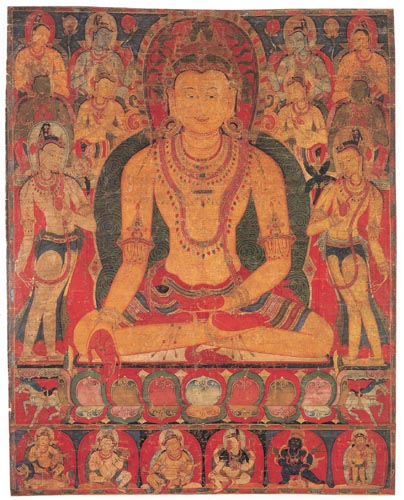|
The five Tathagatas, Celestial Buddhas, comprise one of the most important groups of Esoteric Buddhist
deities described in the Yoga Tantras. Each deity is associated with a color, direction, gesture, and
vehicle: Vairochana (white, zenith, dharmachakra mudra, lion), Akshobhya (blue, east,
bhumisparsha mudra, elephant), Amitabha (red, west, dhyana mudra, peacock),
Ratnasambhava (yellow, south, vajra mudra, horse), and Amoghasiddhi (green, north,
abhaya mudra, Garuda). Each governs a family (kula) of
deities that includes bodhisattvas, a human Buddha, and a goddess.1
Vairochana usually presides over the
group of five.2
Judging by the large number of images that survive from the late twelfth and the first half of the
thirteenth century, the cult of the Tathagatas must have been particularly popular during that period. All five
are depicted with the same format, which is based on an earlier model (see cat.
no. 4). Each is placed on a
lotus seat, flanked by two standing bodhisattvas and a group of seated bodhisattvas. These comprise a chorus
of listeners (shravakas). Typically, the vehicles of the Tathagatas appear at the sides of or beneath their lotus
seats. At the bottom of the thanka is a register of auxiliary deities. No precise explanation for the
assemblage of standing and seated bodhisattvas flanking the Tathagatas has been given.
It has been posited
that the artists were portraying the Tathagatas as they preached to devotees in their heaven.
One would assume that originally each Tathagata had specific attendants. However, in this set, the same two bodhisattvas, Avalokiteshvara and Maitreya, flank three
different Tathagatas. A similar uniformity exists among the seated bodhisattvas in all three
thankas: they make the same hand gestures and their colors are the
same.3 The composition could also simply be a
melding of two standard types of Indian images: the Buddha flanked by standing attendants, which has its
roots in some of the earliest images, and the Buddha flanked by a chorus of listeners, which harks back to
depictions of the historical Buddha preaching in the Tushita (joyful) Heaven before his descent to earth. The
hieratic structure of these compositions with deities of three distinct sizes four, if the lower register is considered is different from what can be observed in Indian
and Nepalese book illustrations. There, the standing attendants and lower register are absent.
The Tathagatas' elaborate garb, which proclaims their elevated status, is worth examining closely. Their jewelry
includes a crown and armlets with triangular jewel-encrusted elements, a series of four necklaces, the lowest
two of which support lotus-bud dangles, and a horizontal pendant amulet. Large earplugs, bangles, and anklets
complete the ensemble. The crowns are attached above the ears by means of ribbons whose ends stream upward. Strands of hair fall to either side of the head, tied above
the shoulders with jeweled bands and ribbons; curly tendrils tumble down the upper arms. The short,
horizontally striped dhotis are attached by elaborate waistbands, tied so that their bifurcated pleated ends
stand up along the top edges of the thighs. Central pleated sashes fall between and under the Tathagatas' legs and
fan out along the tops of the lotus seats. In some instances, a transparent scarf is worn across the shoulders.
These three thankas are all that survive of the original set of five. The painting is particularly fine, and the
extraordinary calm, restraint, and monumentality typical of the best examples of the period are
clearly seen. The drawing is elegant, well rendered, and the color is harmonious. Although the compositions
follow the early model, there are subtle differences in the details. No throne back is indicated, and even the gilded
triangular flanges abutting the upper sides of the pillow are absent. The foliate scrolling associated with the
makara or hamsa has been reduced to an abstract motif
that follows the contour of the pillow (rather than twining behind) and terminates after only two scrolls.
As noted
above, the standing and seated bodhisattvas in all of the paintings are identical, and the only differences, aside
from the main deity, are in the lower registers.4
In each of the thankas, the Tathagatas (Ratnasambhava, Amitabha, and
Amoghasiddhi) are shown in canonical fashion, with their appropriate color, mudra, and vehicle. The deities in
the lower register are identified by inscriptions (most of which can be read), but the system that governed their choice is not apparent. Other thankas of the same Tathagatas have different deities in the bottom register
(see cat. no. 36). In the thanka of Ratnasambhava they include a group of auspicious and wealth-giving deities;
from left to right: Vaishravana, the yaksha Dhanada, probably Jambhala, Ganapati, a fierce blue deity holding a
skull cup and mongoose, and a standing female goddess, probably Vasudhara (who is associated with Jambhala). In the painting of Amitabha, they are Manjushri,
Manidharin, Shadakshari Lokeshvara. Mahavidya, Padmapani, and Tara.
In the Amoghasiddhi, five forms of the goddess Tara and a consecrating monk in front of an offering stand are pictured. As was typical, the Amoghasiddhi was the painting in the set that was reserved to include the
consecrating monk. There must have been a standard order, following the directions for these deities, and
Amoghasiddhi was probably either the first or the last in the list.
SMK
1. See
cat. no. 9 and Mallmann 1986, pp. 36-37. [back]
2. See Matsunaga 1978, pp. xv and xxii, for a discussion of the
evolution of the Vajradhatu mandala in which, earlier, Shakyamuni had reigned in the central position.
[back]
3. It is tempting to see this group of eight bodhisattvas as those
of the Eight Bodhisattva mandala (see cat. no. 28), but the presence of the standing Maitreya and Avalokiteshvara in the
paintings, who are members of this ensemble, seems to negate the possibility. (See also cat. no. 4, note 1.)
[back]
4. A version of the scroll without a source already exists in the
Ford Tara, but there, it clambers up to the top of the nimbus. Compare the Museum of Fine Arts, Boston, book cover, fig. 15.
[back]
|




